Zotac's Ion: The World's First mini-ITX Ion Board
by Anand Lal Shimpi on May 12, 2009 12:00 AM EST- Posted in
- GPUs
SYSMark 2007 Performance
Our journey starts with SYSMark 2007, the only all-encompassing performance suite in our review today. The idea here is simple: one benchmark to indicate the overall performance of your machine.
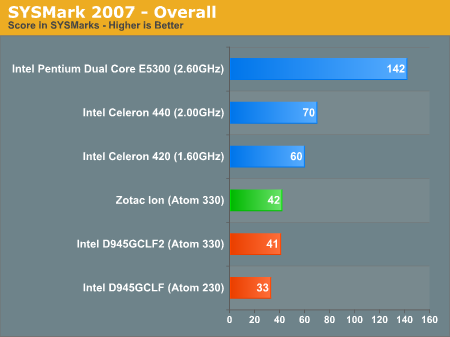
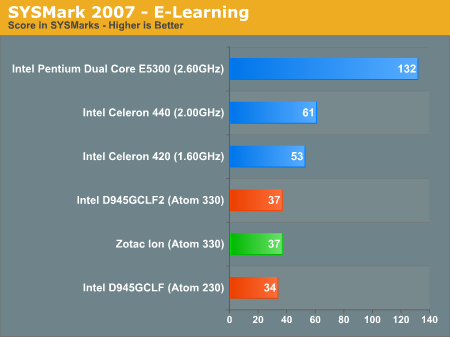
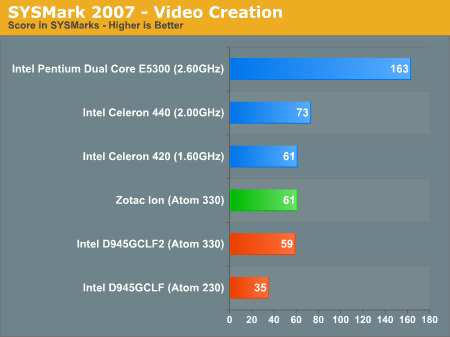
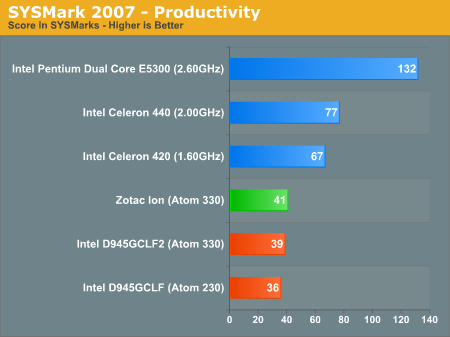

There's a 27% performance improvement realized in SYSMark 2007 when going from the single-core Atom 230 to the dual-core Atom 330. Even the Atom 330 is outperformed by the lowest end Celeron 420 by 43% however.
Note that in general application usage there's no significant performance difference between the Zotac Ion and the Intel D945GCLF2.
And before you get any ideas of replacing a modern day, low-end system with an Ion look at the E5300 score. The E5300 offers 3.4x the speed of the Atom 330. Granted you need a more expensive motherboard but compared to the Zotac Ion, it's not that much more expensive.
Adobe Photoshop CS4 Performance
To measure performance under Photoshop CS4 we turn to the Retouch Artists’ Speed Test. The test does basic photo editing; there are a couple of color space conversions, many layer creations, color curve adjustment, image and canvas size adjustment, unsharp mask, and finally a gaussian blur performed on the entire image.
The whole process is timed and thanks to the use of Intel's X25-M SSD as our test bed hard drive, performance is far more predictable than back when we used to test on mechanical disks.
Time is reported in seconds and the lower numbers mean better performance. The test is multithreaded and can hit all four cores in a quad-core machine.
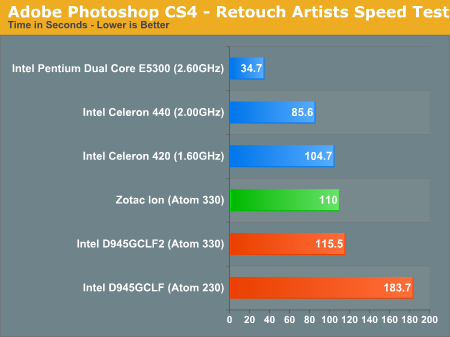
This test was particularly surprising, because with four threads the Atom 330 is able to actually come within striking distance of the Celeron 420's performance - at a considerably lower power consumption. Once we transition to an even more multi-threaded environment where multi-core processors can always maintain a significant performance advantage over their single core brethren then it may be more efficient to toss a few Atom-cores at a problem than something like the Celeron 420. Hmm, perhaps Larrabee will be more useful than we thought...
The single-core Atom 230 is horrendously slow in this test. While the 330 could masquerade as a very low end microprocessor from the modern era, the 230 takes significantly longer to complete our test. No thanks.
The difference between Ion and the D945GCLF2 is negligible.










93 Comments
View All Comments
KidneyBean - Tuesday, May 12, 2009 - link
Isn't it stealing to use Media Player Classic if you use patented decoders without paying for them?If so, I would hope you don't publish such information in articles in the future.
Penti - Friday, May 29, 2009 - link
Nope infringement is never steeling. It's pretty okay as long as it isn't used commercially. Usually your allowed to use any patents for personal use though. So it's fine. You won't go to jail. Of course he won't publish stuff that discourage the use of homebrew codecs and software that are needed for playing warez and illegally ripping your movies. It would be silly as that's what people use computers for, especially htpcs. It would really be a limited worthless device without it.sprockkets - Tuesday, May 12, 2009 - link
With MPEG4, you only pay what you publish with it, not decode.DXA for nvidia cards is clearly documented on how to use it.
Dolby Digital is another story, but seeing as how you can send the bitstream to your receiver to decode it legally, what's the big deal?
Jeffk464 - Tuesday, May 12, 2009 - link
I don't understand what the major need is to have a low power desktop. If it plugs into the wall its not really an issue like it is with notebooks. Its seems like the main focus for a Home Theater PC should be in keeping things quiet. Why not use a notebook processor and focus on making a super quiet heat sink and fan. I like the idea of compact pc's but HP has managed to squeeze a full on systems with a high end cpu onto the back of a lcd display in a nice little package.cosmotic - Tuesday, May 12, 2009 - link
How are Flash (normal animation and (HD)video) and Java graphics performance?For Java, you can install the JDK and double click the jar:
C:\Program Files\Java\jdk1.6.0_13\demo\jfc\Java2D\Java2Demo.jar
The composite and transform demos would be particularly helpful.
Anand Lal Shimpi - Tuesday, May 12, 2009 - link
I've been meaning to talk about FLV performance, I'll try and include that in a short followup soon.Take care,
Anand
strikeback03 - Tuesday, May 12, 2009 - link
The version of the Intel LF2 board you have here is already being pulled from the channel. It's replacement is the LF2D, which loses the S-Video port. Not a huge loss, as most people who tried to use it could not get what they wanted out of it (does not support different content to both the VGA and S-Video ports).Was Vista the OS for all the tests? I am using an LF2 board in my carputer with 1GB RAM, running a somewhat stripped-down version of XP on a 7200RPM 2.5" drive. Running on the car touchscreen (7", 800x480) or in PIP on my desktop monitor, and it feels pretty snappy in general usage. If I give it the full 1920x1200 though it slows down a lot, especially in my front-end software. Also, the image quality over VGA is not as good as some laptops I have hooked up to that monitor over VGA.
For carputer use I would like to see a better onboard audio codec and more ports. The 3-port thing doesn't give much flexibility on inputs and outputs.
Is the increased power consumption of the Intel boards due to using a standard ATX PSU? Did you consider getting one of the Pico-PSUs (like this: http://www.mini-box.com/picoPSU-150-XT-102-power-k...">http://www.mini-box.com/picoPSU-150-XT-102-power-k... ) to try on a more comparable basis? Also, is there any way to test the draw on each rail? The Intel boards are not really compatible with the lower-powered Pico-PSUs due to rather excessive draw on the 5V rail.
Anand Lal Shimpi - Tuesday, May 12, 2009 - link
Vista was the OS used for all of the tests and I'll second what you're saying, I've found XP far snappier than Vista with these Atom based systems. I just stuck with Vista to keep the results somewhat comparable to other CPU results.I did use a standard ATX power supply on the Intel boards but that's why I also tossed in the Eee Box results to show you what an Atom system with a smaller PSU can do.
Take care,
Anand
Jeffk464 - Tuesday, May 12, 2009 - link
I don't understand what the major need is to have a low power desktop. If it plugs into the wall its not really an issue like it is with notebooks. Its seems like the main focus for a Home Theater PC should be in keeping things quiet. Why not use a notebook processor and focus on making a super quiet heat sink and fan. I like the idea of compact pc's but HP has managed to squeeze a full on systems with a high end cpu onto the back of a lcd display in a nice little package.sprockkets - Tuesday, May 12, 2009 - link
Look at the prices on logic supply for a laptop socket itx board and how much the processor is and you will see how much cheaper this setup is.Besides, the vast majority of Anandtech readers prefer to build ourselves, not buy OEM crap.